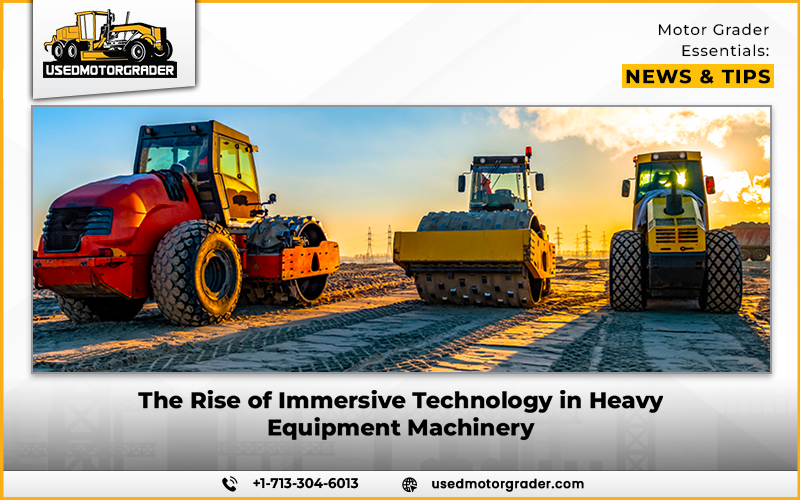Innovation in the Construction and Mining Sectors
Innovation in the construction and mining sectors is not a novel concept, and the emergence of immersive technology is one of the most radical shifts in the past few years. Virtual reality (VR), augmented reality (AR), and digital twins are tools that are redefining the interaction of operators, contractors, and manufacturers with Heavy Equipment Machinery. Immersive solutions are making job sites more efficient and reliable, whether in training, safety, or maintenance.
How Immersive Technology is Changing Training Methods
Training has always been a vital aspect of heavy equipment operations. The conventional approaches were very dependent on physical teachers and practical learning, which usually implied increased expenses and the possibility of accidents during the learning process. Immersive technology is changing that paradigm today.
VR simulators offer realistic training conditions in which operators can be trained to operate bulldozers, excavators, and graders without having to set foot on a job site. These virtual simulations replicate real-world conditions, such as irregular terrain and equipment failures, and train operators to handle challenges they will encounter in the field. Equally, AR applications superimpose digital data on physical equipment and direct operators in their work step by step.
This method not only ensures safer training but also speeds up learning, as operators practice in a controlled environment before handling real machinery.
Enhanced Maintenance and Repair Through AR
Maintenance of machines is critical to productivity. Maintenance and repair no longer rely on paper manuals or guesswork, thanks to immersive technology. AR headsets allow technicians to receive real-time diagnostic information when on machines.
Remote support is also possible; experts miles away can guide technicians with visual instructions to ensure proper repairs.
- Quick resolution of mechanical issues
- Less downtime and maintenance expenses
- Greater precision in maintenance activities
Contractors save time and money by minimizing errors and downtime, and this directly affects the efficiency of the project.
Digital Twins to Boost On-Site Productivity
The use of digital twins is another innovative use of immersive technology. A digital twin is a simulated representation of physical equipment that can update in real time based on sensor and IoT device data. For Heavy Equipment Machinery, this means operators and managers can monitor machine performance in real time.
- Live-based predictive maintenance
- Better project planning and scheduling
- Efficient fuel and resource consumption
Knowing this, teams are able to foresee problems before they turn into expensive failures and make more informed choices regarding equipment deployment. The outcome is smoother workflows and reduced unforeseen job site downtime.
Immersive Solutions for Safety Improvements
The issues of safety have been of primary concern in the industries that are dependent on heavy machinery. Immersive technology provides new tools to safeguard operators and workers. VR safety training programs enable employees to simulate potentially dangerous situations, such as operating on unsteady surfaces or during unfavorable weather, without being in any actual harm.
- Reduces incidents at workplaces
- Develops trust in operators before working on actual machines
- Improves safety standards
Training in simulated conditions helps workers develop quick reflexes and strong safety habits. This not only avoids accidents but also assists companies in being in line with rigid safety rules.
Influence on Equipment Design and Development
Immersive technology is also helping manufacturers to enhance the design and construction of equipment. VR and AR applications allow engineers to create virtual prototypes and make decisions without the expense of full production. They can test ergonomics, visibility, and controls, and ensure that machines are not only functional but also user-friendly.
- Quick testing of new equipment features
- Improved ergonomics and operator-friendly cabins
- Efficient innovation processes
The process aids manufacturers in introducing superior and safer equipment to the market at a quicker rate, and at the same time, it lowers the cost of development. It is a win-win situation for both manufacturers and contractors who rely on Heavy Equipment Machinery.
Challenges and Considerations
Although immersive technology offers major advantages, it also comes with challenges. These solutions need a lot of initial investment in hardware and software. The cost can be hard to justify for smaller contractors, especially those without a large fleet.
It also requires professional trainers and support staff who are knowledgeable about heavy equipment and computer technology. Remote job sites may also face connectivity issues, which are critical for real-time AR and digital twin applications.
In Review
Immersive technology is not merely a concept of the future, but it is already transforming the way the construction and mining sectors are training, ensuring safety, maintaining, and designing. Integrating VR, AR, and digital twins into daily operations is helping companies improve efficiency, minimize risks, and unlock new opportunities for innovation. Immersive solutions will become a part of the Heavy Equipment Machinery environment as they become more widespread and their prices drop.
FAQs
Q1. What are the most popular immersive technologies in heavy equipment?
A: The most used ones are VR simulators to train operators, AR overlays to maintain and repair equipment, and digital twins to monitor equipment in real time.
Q2. How does immersive training compare to traditional operator training?
A: Immersive training is less dangerous, quicker, and cheaper. It enables the operators to train in a risk-free environment prior to working with actual equipment.
Q3. Can smaller contractors use immersive solutions?
A: Yes, however, the price may be an obstacle. A large number of smaller contractors receive immersive training via equipment rental firms or joint training facilities.
Q4. How will digital twins be used in heavy machinery?
A: Digital twins are most likely to become the norm, as they will assist contractors to monitor performance, anticipate failures, and optimize resource consumption in each project.
Tags: used construction equipment for sale, used graders for sale in Texas, used motor graders Texas


